Graphic:
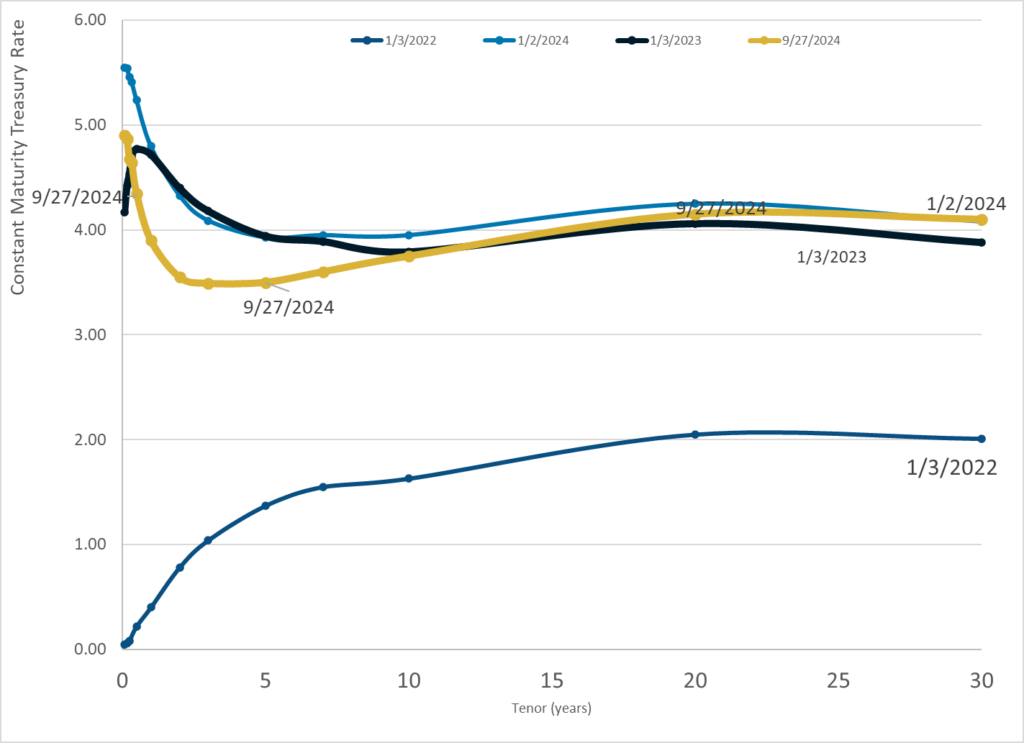
Publication Date: 27 Sept 2024
Publication Site: Treasury Dept
All about risk
Graphic:

Publication Date: 27 Sept 2024
Publication Site: Treasury Dept
Graphic:

Publication Date: 24 Sept 2024
Publication Site: Treasury Dept
Link: https://www.visualcapitalist.com/growth-in-working-age-populations-over-10-years/
Graphic:
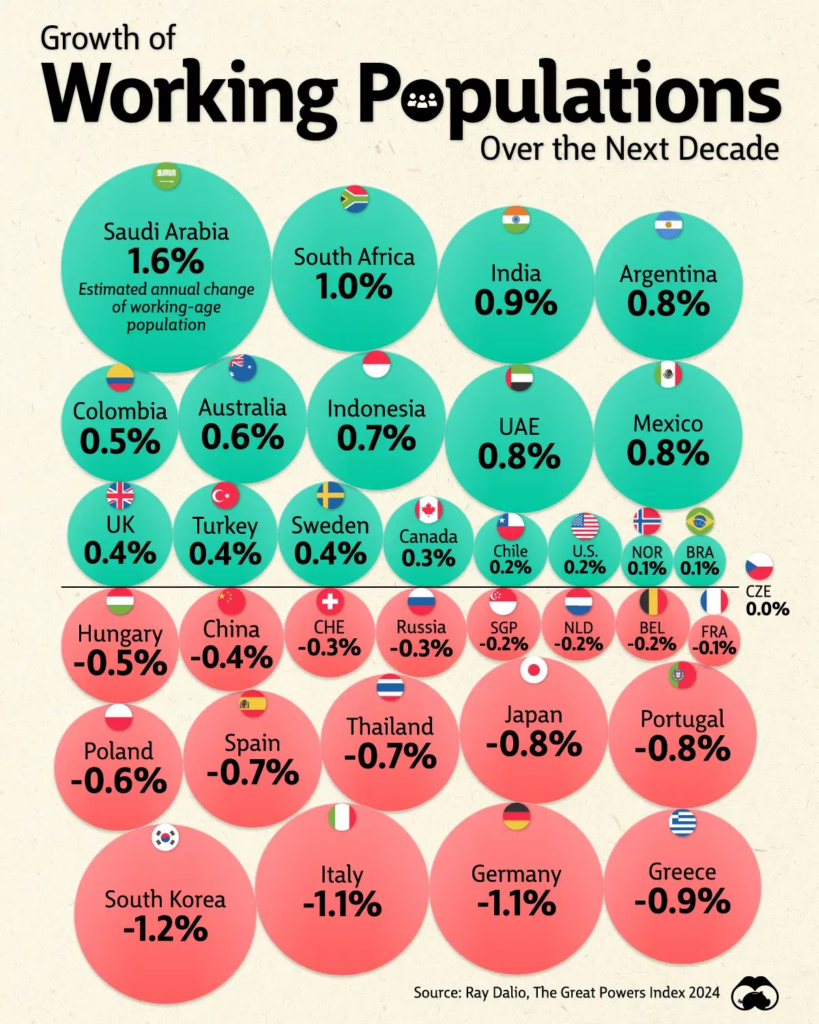
Excerpt:
Today, the working age population in almost half of U.S. metropolitan areas has declined due to demographic shifts, and this trend is set to continue.
As a result, the U.S. workforce is projected to grow at just 0.2% annually over the next decade, roughly a quarter of the rate of markets like India and Mexico. Given the low birth rates and aging populations across many advanced economies, the world’s workforce is set to change significantly, with implications for economic and productivity growth.
This graphic shows the projected growth in major economies’ working age population, based on analysis from Ray Dalio’s Great Powers Index 2024.
Author(s): Dorothy Neufeld
Publication Date: 23 Sept 2024
Publication Site: Visual Capitalist
Link: https://www.kiplinger.com/retirement/longevity-illustrator-find-out-how-long-you-might-live
Excerpt:
When planning for retirement, it’s important to consider all the risks, and one consideration that individuals often overlook is “longevity risk.” Longevity risk refers to the chance a person could outlive their savings. Understanding longevity and reasonably estimating the probabilities of living to various advanced ages and the risk of outliving resources are important for planning a secure retirement.
As a result of healthy lifestyles, medical advancements and scientific discoveries, it has become much more common for people these days to live into their 80s and 90s — or even their 100s! In fact, Pew Research Center writes that, according to estimates by the U.S. Census Bureau, there are about 101,000 centenarians in the U.S. in 2024, and this population could quadruple to about 422,000 in 2054.
While a long life is something most people desire, it requires planning for a longer retirement than in the past. For example, if a worker retires at 67, planning for a 20-year retirement may not be enough, and if they live to be in their 90s, or even past 100, they could outlive their savings or end up with fewer assets to leave their heirs.
Author(s): Lisa A. Schilling, FSA, EA, FCA, MAAA
Publication Date: 22 Sept 2024
Publication Site: Kiplinger Personal Finance
Link: https://www.soa.org/resources/research-reports/2024/ai-mortality-essay-collection/
Graphic:

Excerpt:
The Society of Actuaries (SOA) Research Institute’s Mortality and Longevity Strategic Research Program Steering Committee issued a call for essays to explore the application of artificial intelligence (AI) to mortality and longevity. The objective was to gather a variety of perspectives and experiences on the use of AI in mortality modeling, forecasting and prediction to promote discussion and future research around this topic.
The collection includes six essays that were accepted for publication from all submissions. Two essays were chosen for prizes based on their creativity, originality, and likelihood of further thought on the subject matter.
Author(s): multiple
Publication Date: September 2024
Publication Site: Society of Actuaries, SOA Research Institute
Link: https://www.actuary.org/sites/default/files/2024-09/professionalism-paper-generative-ai.pdf
Graphic:

Excerpt:
This paper describes the use and professionalism considerations for actuaries using
generative artificial intelligence (GenAI) to provide actuarial services. GenAI generates text,
quantitative, or image content based on training data, typically using a large language model
(LLM). Examples of GenAI deployments include Open AI GPT, Google Gemini, Claude,
and Meta. GenAI transforms information acquired from training data into entirely new
content. In contrast, predictive AI models analyze historical quantitative data to forecast
future outcomes, functioning like traditional predictive statistical models.
Actuaries have a wide range of understanding of AI. We assume the reader is broadly
familiar with AI and AI model capabilities, but not necessarily a designer or expert user. In
this paper, the terms “GenAI,” “AI,” “AI model(s),” and “AI tool(s)” are used interchangeably.
This paper covers the professionalism fundamentals of using GenAI and only briefly
discusses designing, building, and customizing GenAI systems. This paper focuses on
actuaries using GenAI to support actuarial conclusions, not on minor incidental use of AI
that duplicates the function of tools such as plug-ins, co-pilots, spreadsheets, internet search
engines, or writing aids.
GenAI is a recent development, but the actuarial professionalism framework helps actuaries
use GenAI appropriately: the Code of Professional Conduct, the Qualification Standards
for Actuaries Issuing Statements of Actuarial Opinion in the United States (USQS), and the
actuarial standards of practice (ASOPs). Although ASOP No. 23, Data Quality; No. 41,
Actuarial Communications; and No. 56, Modeling, were developed before GenAI was widely
available, each applies in situations when GenAI may now be used. The following discussion
comments on these topics, focusing extensively on the application of ASOP No. 56, which
provides guidance for actuaries when they are designing, developing, selecting, modifying,
using, reviewing, or evaluating models. GenAI is a model; thus ASOP No. 56 applies.
The paper explores use cases and addresses conventional applications, including quantitative
and qualitative analysis, as of mid-2024, rather than anticipating novel uses or combinations
of applications. AI tools change quickly, so the paper focuses on principles rather than
the technology. The scope of this paper does not include explaining how AI models are
structured or function, nor does it offer specific guidelines on AI tools or use by the actuary
in professional settings. Given the rapid rate of change within this space, the paper makes no
predictions about the rapidly evolving technology, nor does it speculate on future challenges
to professionalism.
Author(s): Committee on Professional Responsibility of the American Academy of Actuaries
Committee on Professional
Responsibility
Geoffrey C. Sandler, Chairperson
Brian Donovan
Richard Goehring
Laura Maxwell
Shawn Parks
Matthew Wininger
Kathleen Wong
Yukki Yeung
Paul Zeisler
Melissa Zrelack
Artificial Intelligence Task Force
Prem Boinpally
Laura Maxwell
Shawn Parks
Fei Wang
Matt Wininger
Kathy Wong
Yukki Yeung
Publication Date: September 2024
Publication Site: American Academy of Actuaries
Link: https://www.cdc.gov/nchs/nvss/vsrr/drug-overdose-data.htm
Graphic:
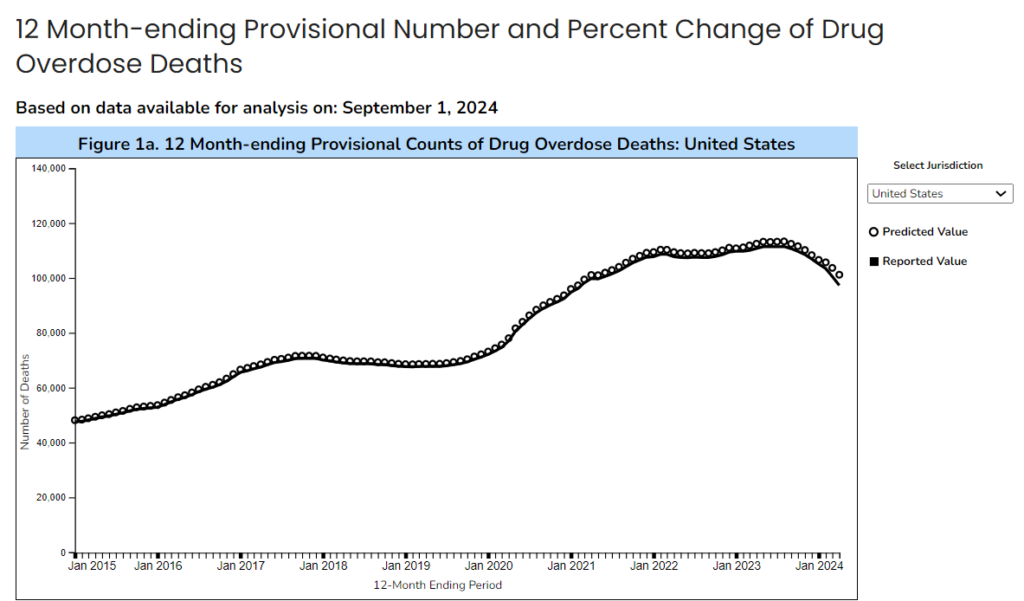
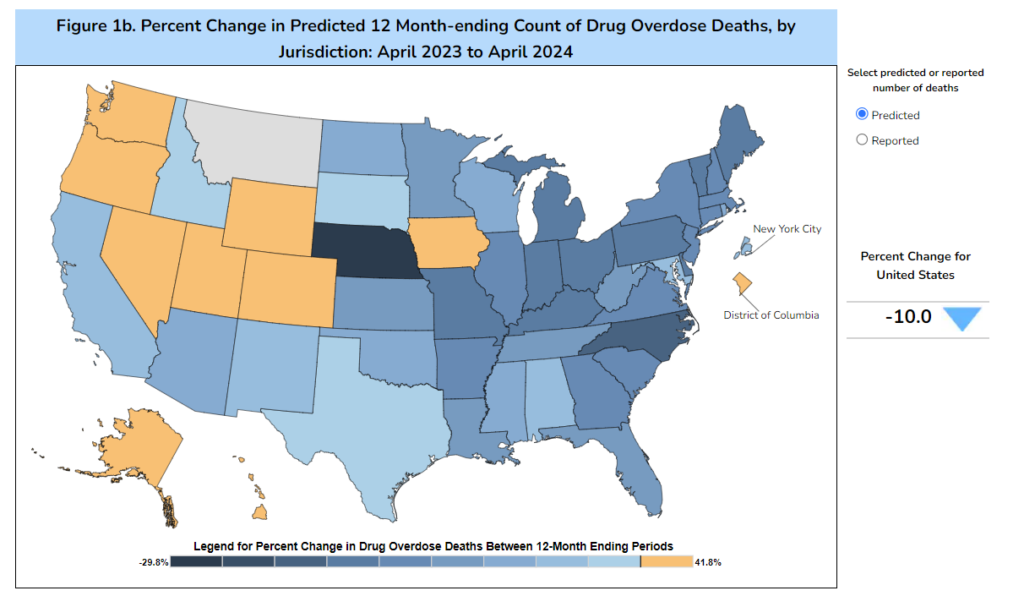
Excerpt:
This data visualization presents provisional counts for drug overdose deaths based on a current flow of mortality data in the National Vital Statistics System. Counts for the most recent final annual data are provided for comparison. National provisional counts include deaths occurring within the 50 states and the District of Columbia as of the date specified and may not include all deaths that occurred during a given time period. Provisional counts are often incomplete and causes of death may be pending investigation (see Technical notes) resulting in an underestimate relative to final counts. To address this, methods were developed to adjust provisional counts for reporting delays by generating a set of predicted provisional counts (see Technical notes).
The provisional data presented in this visualization include: (a) the reported and predicted provisional counts of deaths due to drug overdose occurring nationally and in each jurisdiction; (b) a U.S. map of the percentage changes in provisional drug overdose deaths for the current 12 month-ending period compared with the 12-month period ending in the same month of the previous year, by jurisdiction; and (c) the reported and predicted provisional counts of drug overdose deaths involving specific drugs or drug classes occurring nationally and in selected jurisdictions. The reported and predicted provisional counts represent the numbers of deaths due to drug overdose occurring in the 12-month periods ending in the month indicated. These counts include all seasons of the year and are insensitive to variations by seasonality. Deaths are reported by the jurisdiction in which the death occurred.
Several data quality metrics, including the percent completeness in overall death reporting, percentage of deaths with cause of death pending further investigation, and the percentage of drug overdose deaths with specific drugs or drug classes reported are included to aid in interpretation of provisional data as these measures are related to the accuracy of provisional counts (see Technical notes). Reporting of the specific drugs and drug classes involved in drug overdose deaths varies by jurisdiction, and comparisons of death rates involving specific drugs across selected jurisdictions should not be made (see Technical notes). Provisional data presented in this visualization will be updated on a monthly basis as additional records are received.
Publication Date: Accessed 19 Sept 2024
Publication Site: National Center for Health Statistics, CDC
Graphic:
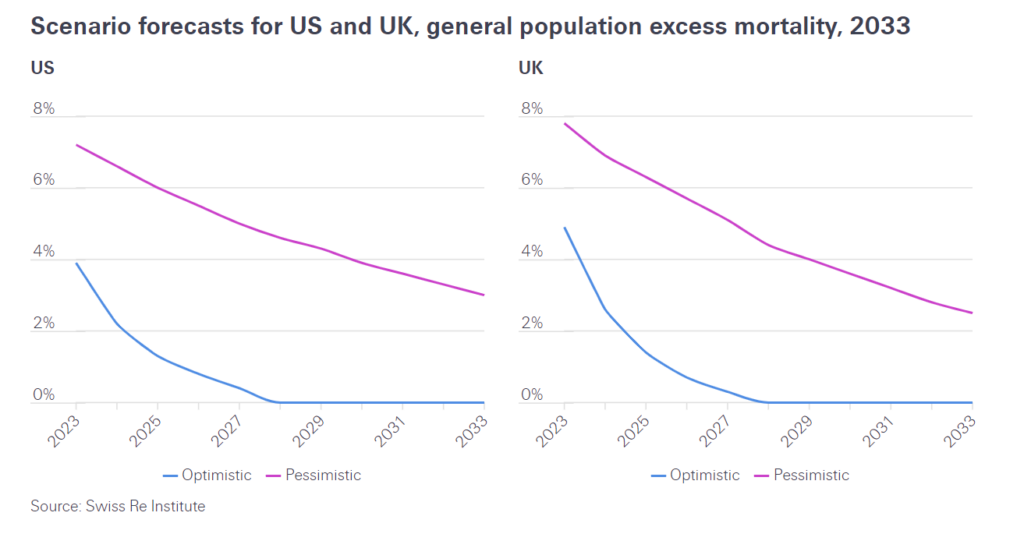
Excerpt:
Four years on from the outbreak of the pandemic in 2020, many countries worldwide still report elevated deaths in their populations. This impact appears generally independent of healthcare systems and population health. This trend is evident even after accounting for shifting population sizes, and the range of reporting mechanisms and death classifications that make inter-country comparisons complex. There is also likely a degree of excess mortality under-reporting.
Quantifying excess mortality has been an acute challenge since 2020 due to the exceptional mortality rates of the pandemic. Excess mortality refers to the number of deaths over and above an assumed “expected” number of deaths. The different methods of estimating expected mortality can generate very different excess mortality rates.
This represents a potential challenge for Life and Health (L&H) insurance, with potentially several years of elevated mortality claims ahead, depending on how general population trends translate into the insured population. Ongoing excess mortality can have implications for L&H insurance claims and reserves. Excess mortality that continues to exceed current expectations may affect the long-term performance of in-force life portfolios as well as the pricing of new life policies.
Author(s): By Daniel Meier, Life & Health R&D Manager, CUO L&H Reinsurance & Prachi Patkee, Life & Health R&D Analyst, CUO L&H Reinsurance & Adam Strange, Life & Health R&D Manager, CUO L&H Reinsurance
Publication Date: 16 Sept 2024
Publication Site: Swiss Re Institute
Graphic:
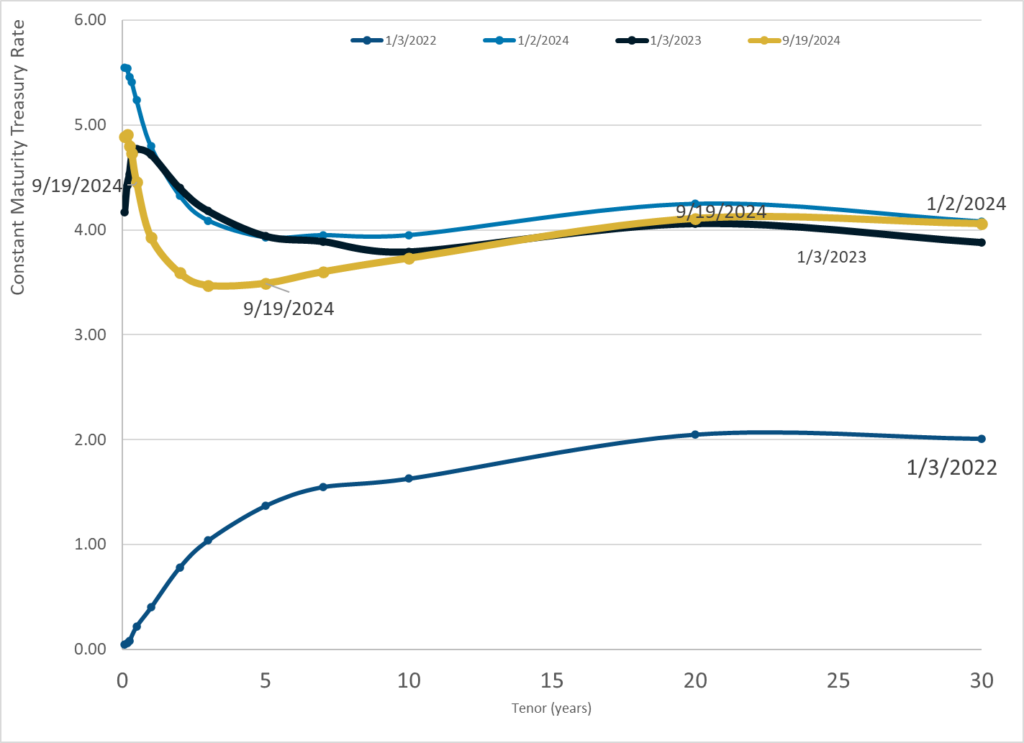
Publication Date: 19 Sept 2024
Publication Site: Treasury Dept
Graphic:
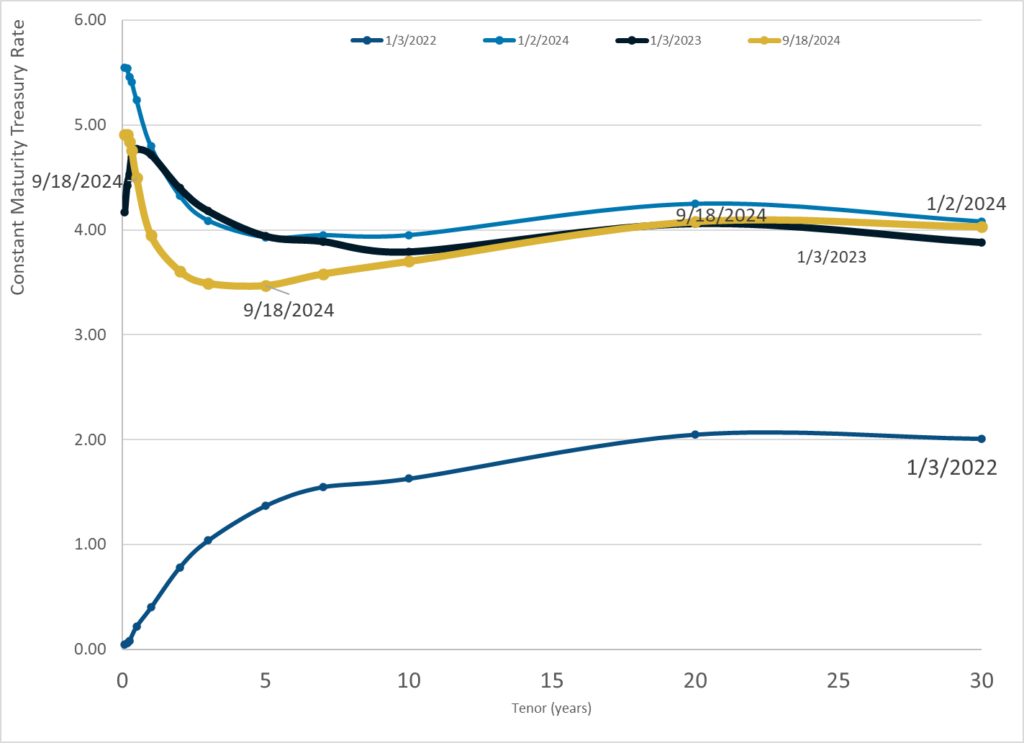
Publication Date: 18 Sept 2024
Publication Site: Treasury Dept
Link: https://www.cnbc.com/2024/09/18/fed-cuts-rates-september-2024-.html
Graphic:

Excerpt:
WASHINGTON – The Federal Reserve on Wednesday enacted its first interest rate cut since the early days of the Covid pandemic, slicing half a percentage point off benchmark rates in an effort to head off a slowdown in the labor market.
With both the jobs picture and inflation softening, the central bank’s Federal Open Market Committee chose to lower its key overnight borrowing rate by a half percentage point, or 50 basis points, affirming market expectations that had recently shifted from an outlook for a cut half that size.
Outside of the emergency rate reductions during Covid, the last time the FOMC cut by half a point was in 2008 during the global financial crisis.
The decision lowers the federal funds rate to a range between 4.75%-5%. While the rate sets short-term borrowing costs for banks, it spills over into multiple consumer products such as mortgages, auto loans and credit cards.
In addition to this reduction, the committee indicated through its “dot plot” the equivalent of 50 more basis points of cuts by the end of the year, close to market pricing. The matrix of individual officials’ expectations pointed to another full percentage point in cuts by the end of 2025 and a half point in 2026. In all, the dot plot shows the benchmark rate coming down about 2 percentage points beyond Wednesday’s move.
Author(s): Jeff Cox
Publication Date: 18 Sept 2024
Publication Site: CNBC
Link: https://ijpds.org/article/view/1145
doi: 10.23889/ijpds.v5i1.1145
Graphic:

Excerpt:
Introduction
More than 30 million adults are released from incarceration globally each year. Many experience complex physical and mental health problems, and are at markedly increased risk of preventable mortality. Despite this, evidence regarding the global epidemiology of mortality following release from incarceration is insufficient to inform the development of targeted, evidence-based responses. Many previous studies have suffered from inadequate power and poor precision, and even large studies have limited capacity to disaggregate data by specific causes of death, sub-populations or time since release to answer questions of clinical and public health relevance.
Objectives
To comprehensively document the incidence, timing, causes and risk factors for mortality in adults released from prison.
Methods
We created the Mortality After Release from Incarceration Consortium (MARIC), a multi-disciplinary collaboration representing 29 cohorts of adults who have experienced incarceration from 11 countries. Findings across cohorts will be analysed using a two-step, individual participant data meta-analysis methodology.
Results
The combined sample includes 1,337,993 individuals (89% male), with 75,795 deaths recorded over 9,191,393 person-years of follow-up.
Conclusions
The consortium represents an important advancement in the field, bringing international attention to this problem. It will provide internationally relevant evidence to guide policymakers and clinicians in reducing preventable deaths in this marginalized population.
Author(s): Borschmann, R., Tibble, H., Spittal, M. J., Preen, D., Pirkis, J., Larney, S., Rosen, D. L., Young, J. T., Love, A. D., Altice, F. L., Binswanger, I. A., Bukten, A., Butler, T., Chang, Z., Chen, C.-Y., Clausen, T., Christensen, P. B., Culbert, G. J., Degenhardt, L., Dirkzwager, A. J., Dolan, K., Fazel, S., Fischbacher, C., Giles, M., Graham, L., Harding, D., Huang, Y.-F., Huber, F., Karaminia, A., Kouyoumdjian, F. G., Lim, S., Møller, L., Moniruzzaman, A., Morenoff, J., O’Moore, E., Pizzicato, L. N., Pratt, D., Proescholdbell, S. F., Ranapurwala, S. I., Shanahan, M. E., Shaw, J., Slaunwhite, A., Somers, J. M., Spaulding, A. C., Stern, M. F., Viner, K. M., Wang, N., Willoughby, M., Zhao, B. and Kinner, S. A.
Publication Date: February 2020
Publication Site: International Journal of Population Data Science